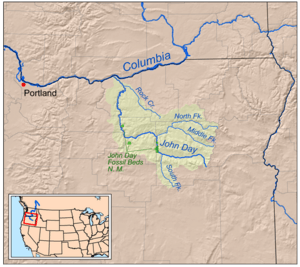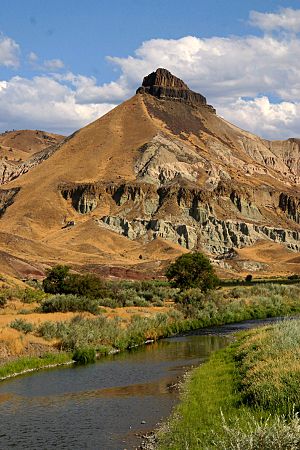John Day River facts for kids
Quick facts for kids John Day River |
|
|---|---|

John Day River at Clarno
|
|

Map of the John Day watershed
|
|
| Country | United States |
| State | Oregon |
| Physical characteristics | |
| Main source | Strawberry Mountains Malheur National Forest, Grant County 6,681 ft (2,036 m) 44°14′44″N 118°33′08″W / 44.245439°N 118.5521617°W |
| River mouth | Columbia River 268 ft (82 m) 45°43′57″N 120°38′57″W / 45.7326252°N 120.6492244°W |
| Length | 284 mi (457 km) |
| Basin features | |
| Basin size | 8,000 sq mi (21,000 km2) |
| Tributaries |
|
| Type: | Recreational |
| Designated: | October 28, 1988 |

The John Day River is a long river in eastern Oregon, United States. It flows into the Columbia River. This river is about 284 miles (457 kilometers) long. It is special because it has no dams along its entire length. This makes it the fourth longest free-flowing river in the United States.
People use the river's water to help grow crops. The river is also home to many different animals. These include wild steelhead and Chinook salmon. However, the steelhead fish are protected by law because their numbers are low. Chinook salmon might also need this protection soon.
The river got its name from a fur trapper named John Day. He was part of an expedition that traveled across the country in 1810. In 1812, John Day and his friend Ramsay Crooks were robbed near the river's mouth. They had to walk 80 miles (129 km) to find help.
Because there are no dams, the river's water level changes a lot. It depends on how much snow melts and how much rain falls. The highest water level ever recorded was on January 2, 1997. Sometimes, the river has almost no water at all. This happened for several days in 1966, 1973, and 1977. On average, the river flows at about 2,075 cubic feet (58.8 m³) per second.
Where the River Flows
The John Day River collects water from a large area. This area includes much of the western Blue Mountains. The river flows through a dry part of Oregon, east of the Cascade Range. It winds its way northwest before joining the Columbia River.
The river flows through beautiful canyons in its upper parts. You can find important fossil sites along its banks. The land around the river ranges from 268 feet (82 m) at its mouth to over 9,000 feet (2,700 m) in the Strawberry Mountains.
The main part of the John Day River starts in the Strawberry Mountains. This is in eastern Grant County. Other parts, called forks, also join the main river. The North Fork starts in the Elkhorn Mountains. The Middle Fork begins in the Blue Mountains. The South Fork starts in northern Harney County. All these forks begin in national forests like the Malheur National Forest and the Wallowa-Whitman National Forest.
The main river first flows north, then west. It passes through towns like Prairie City, John Day, and Mount Vernon. At Dayville, the South Fork joins it. Then, the river flows north through Picture Gorge. It also passes by the Sheep Rock Unit of the John Day Fossil Beds National Monument.
Near Kimberly, the North Fork joins the river. The North Fork has already joined with the Middle Fork. The river then flows west through Wheeler County. As it gets closer to the Columbia River, it starts to curve a lot. It forms the border between Sherman County and Gilliam County.
The John Day River meets the Columbia River about 16 miles (26 km) northeast of Biggs. The river's mouth is on a narrow part of the Columbia River called Lake Umatilla. This lake is formed by the John Day Dam.
Fun on the River and Its Wildlife
People can go rafting and use other small boats on the John Day River. You need to get a permit to do this.
Farmers use the lower part of the river to water their crops and for ranching. In 1988, the United States Congress decided to protect 147.5 miles (237.4 km) of the river. This part, from Service Creek to Tumwater Falls, is now a Wild and Scenic River. This means it is protected for its natural beauty and for people to enjoy.
The river is a great place for fishing. People like to fish for steelhead and warm water bass. It's also popular for whitewater rafting.
Besides wild spring chinook salmon and bass, the river is home to other fish. These include Columbia River redband trout, bull trout, and westslope cutthroat trout. No hatchery-raised salmon or steelhead are released into the John Day River. This helps keep the wild fish populations strong.
See also
 In Spanish: Río John Day para niños
In Spanish: Río John Day para niños

